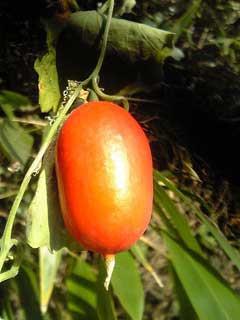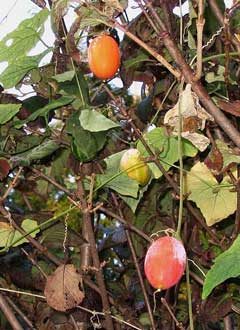 |
|
commons.wikimedia.org/wiki/User:Koba-chan |
 |
| commons.wikimedia.org/wiki/User:Sphl |
Translate this page:
Summary
Physical Characteristics
![]()
![]() Trichosanthes ovigera is a PERENNIAL CLIMBER at a fast rate.
Trichosanthes ovigera is a PERENNIAL CLIMBER at a fast rate.
See above for USDA hardiness. It is hardy to UK zone 10 and is frost tender. It is in leaf from May to October, in flower from July to September, and the seeds ripen from September to October. The species is monoecious (individual flowers are either male or female, but both sexes can be found on the same plant) and is pollinated by Insects.
Suitable for: light (sandy), medium (loamy) and heavy (clay) soils and prefers well-drained soil. Suitable pH: mildly acid, neutral and basic (mildly alkaline) soils. It cannot grow in the shade. It prefers moist soil.
UK Hardiness Map
US Hardiness Map
Synonyms
T. cucumeroides. Maxim.
Plant Habitats
Cultivated Beds;
Edible Uses
Edible Parts: Fruit Root
Edible Uses:
An edible starch is obtained from the root[2, 46, 61, 183]. The immature fruit is preserves in miso or salt[183]. The mature fruit is about 7cm long[200]. A nutritional analysis is available[218]. We have no record of the seed being edible, though there is no reason to believe that it should not be[K]. Like the edible seeds of many members of this plant family, the seed is eaten in the Orient as a vermifuge[218]. The seed contains 33.8% protein and 56.3% fat[218].
References More on Edible Uses
| Composition
|
| Figures in grams (g) or miligrams (mg) per 100g of food.
|
|
|
Fruit (Dry weight)
|
|
- 316 Calories per 100g
- Water : 0%
- Protein: 15.8g; Fat: 0g; Carbohydrate: 78.9g; Fibre: 8.8g; Ash: 5.3g;
- Minerals - Calcium: 333mg; Phosphorus: 596mg; Iron: 17.5mg; Magnesium: 0mg; Sodium: 0mg; Potassium: 2159mg; Zinc: 0mg;
- Vitamins - A: 14210mg; Thiamine (B1): 0.7mg; Riboflavin (B2): 0.9mg; Niacin: 12.3mg; B6: 0mg; C: 105mg;
- Reference: [ 218]
- Notes:
|
|
Medicinal Uses
Plants For A Future can not take any responsibility for any adverse effects from the use of plants. Always seek advice from a professional before using a plant medicinally.
Anodyne Antiphlogistic Blood purifier Diuretic Febrifuge Poultice Vermifuge
Diuretic[116]. The seed is vermifuge[218]. The root is anodyne, antiphlogistic, blood purifier, depurative, febrifuge and resolvent[147]. It is used as a poultice or made into a decoction to treat abscesses, boils, fevers, sore throats etc[147, 218]. The fruit is used to treat coughs, diabetes, jaundice etc[218].
References More on Medicinal Uses
The Bookshop: Edible Plant Books
Our Latest books on Perennial Plants For Food Forests and Permaculture Gardens in paperback or digital formats.

Edible Tropical Plants
Food Forest Plants for Hotter Conditions: 250+ Plants For Tropical Food Forests & Permaculture Gardens.
More

Edible Temperate Plants
Plants for Your Food Forest: 500 Plants for Temperate Food Forests & Permaculture Gardens.
More

More Books
PFAF have eight books available in paperback and digital formats. Browse the shop for more information.
Shop Now
Other Uses
Soap
The dried fruit is a soap substitute[46, 61, 116].
Special Uses
References More on Other Uses
Cultivation details
Requires a rich well-drained soil and plenty of moisture in the growing season[1]. Plants are not hardy in Britain and normally require greenhouse cultivation[200], but it may be possible to grow them as a spring-sown annual in a very warm sheltered bed outdoors[1].
References Carbon Farming Information and Carbon Sequestration Information
Temperature Converter
Type a value in the Celsius field to convert the value to Fahrenheit:
Fahrenheit:
The PFAF Bookshop
Plants For A Future have a number of books available in paperback and digital form. Book titles include Edible Plants, Edible Perennials, Edible Trees,Edible Shrubs, Woodland Gardening, and Temperate Food Forest Plants. Our new book is Food Forest Plants For Hotter Conditions (Tropical and Sub-Tropical).
Shop Now
Plant Propagation
Seed - sow March in pots in a warm greenhouse in a rich soil. Sow 2 - 3 seeds per pot and thin to the strongest plant. Grow them on fast and plant out after the last expected frosts. Give some protection, such as a frame or cloche, until the plants are growing away well.
Other Names
If available other names are mentioned here
Native Range
TEMPERATE ASIA: China (Guangdong Sheng, Guangxi Zhuangzu Zizhiqu, Guizhou Sheng, Hainan Sheng, Hunan Sheng, Jiangxi Sheng, Sichuan Sheng, Xizang Zizhiqu (southeast), Yunnan Sheng, Zhejiang Sheng), Japan (Honshu, Kyushu, Ryukyu Islands, Shikoku), Taiwan TROPICAL ASIA: Bangladesh, India (north), Nepal, Indonesia (Papua), Papua New Guinea, Solomon Islands, Myanmar, Thailand, Vietnam, Indonesia (Jawa, Kalimantan, Lesser Sunda Islands, Maluku, Sulawesi, Sumatera), Malaysia, Philippines (Luzon, Mindanao), Singapore AUSTRALASIA: Australia (Queensland (northeast), Western Australia (northeast), Northern Territory)
Weed Potential
Right plant wrong place. We are currently updating this section.
Please note that a plant may be invasive in one area but may not in your area so it's worth checking.
Conservation Status
IUCN Red List of Threatened Plants Status :

Growth: S = slow M = medium F = fast. Soil: L = light (sandy) M = medium H = heavy (clay). pH: A = acid N = neutral B = basic (alkaline). Shade: F = full shade S = semi-shade N = no shade. Moisture: D = dry M = Moist We = wet Wa = water.
Now available:
Food Forest Plants for Mediterranean Conditions
350+ Perennial Plants For Mediterranean and Drier Food Forests and Permaculture Gardens.
[Paperback and eBook]
This is the third in Plants For A Future's series of plant guides for food forests tailored to
specific climate zones. Following volumes on temperate and tropical ecosystems, this book focuses
on species suited to Mediterranean conditions—regions with hot, dry summers and cool, wet winters,
often facing the added challenge of climate change.
Read More
Expert comment
Author
Blume.
Botanical References
58200266
Links / References
For a list of references used on this page please go here
Readers comment
| Add a comment |
|
If you have important information about this plant that may help other users please add a comment or link below. Only comments or links that are felt to be directly relevant to a plant will be included. If you think a comment/link or information contained on this page is inaccurate or misleading we would welcome your feedback at [email protected]. If you have questions about a plant please use the Forum on this website as we do not have the resources to answer questions ourselves.
* Please note: the comments by website users are not necessarily those held by PFAF and may give misleading or inaccurate information.
To leave a comment please Register or login here All comments need to be approved so will not appear immediately.
|
Subject : Trichosanthes ovigera
|
|
|
|